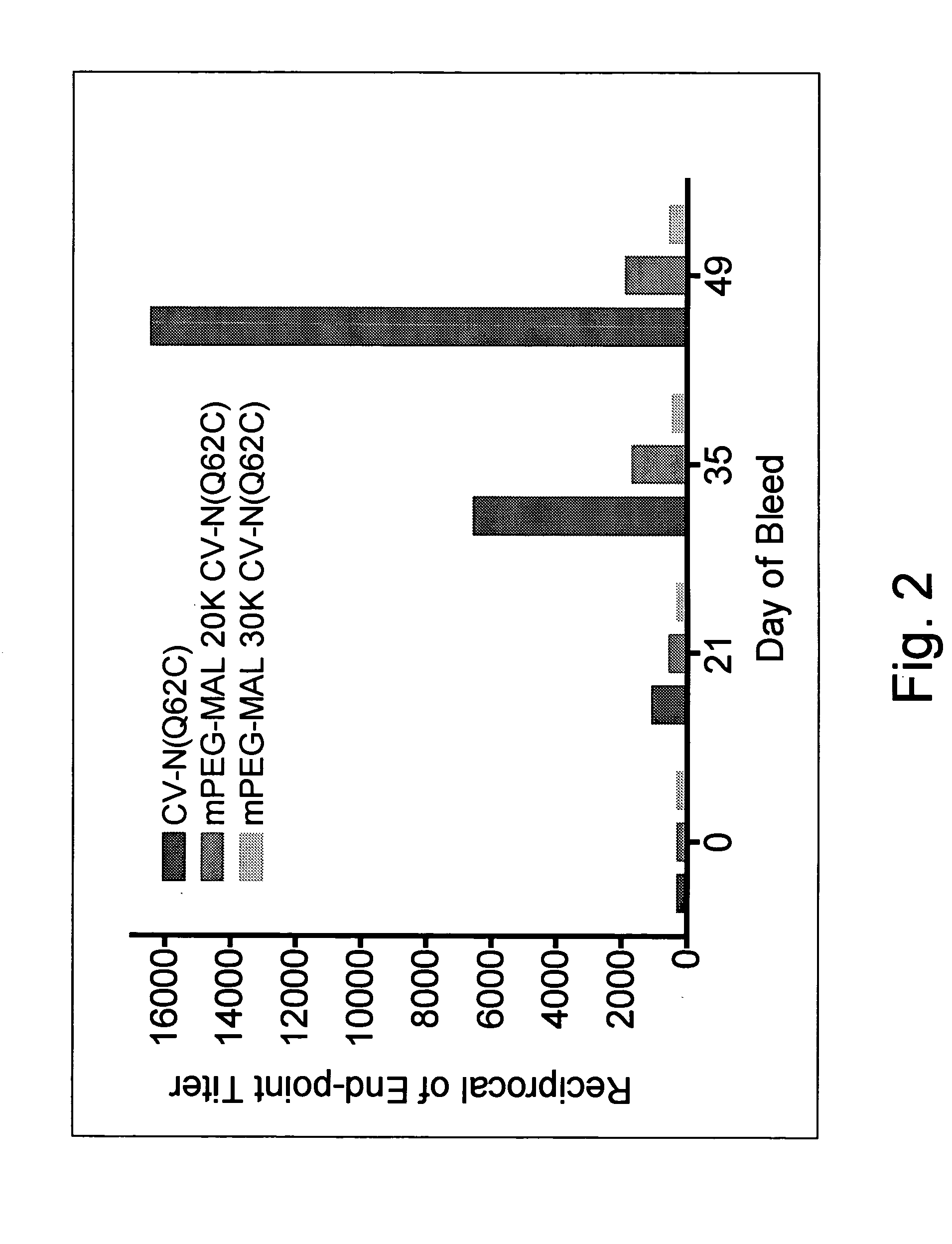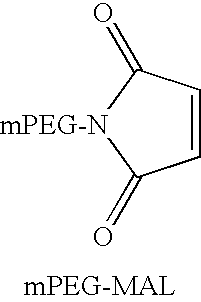Cyanovirin variant-polymer conjugates
a technology of variant polymer and cyanovirin, which is applied in the field of protein polymer conjugates, can solve the problems of affecting the development of cyanovirin-n protein therapies, affecting the effect of cyanovirin-n protein therapy, and relatively short half-life,
- Summary
- Abstract
- Description
- Claims
- Application Information
AI Technical Summary
Problems solved by technology
Method used
Image
Examples
example 2
Mutagenedid of Cyanovirin-N Coding Sequence
[0273]Positions gln14 and gln62 were selected as being particularly preferred for substitution with a cysteine residue, due to their distance from the reported active sites of native cyanovirin (Bewley, Calif., Structure (Camb)., 2001, 9(10):931-40). The first site selected for substitution was gln62.
[0274]The gene encoding cyanovirin-N (CV-N) was obtained from the National Cancer Institute (see U.S. Patent Application Publication No. US 2002 / 0127675, which is incorporated herein by reference). The gene contained the coding sequence SEQ ID NO: 9 and had been cloned into the pET26(b) expression vector (Novagen, Madison, Wis.), which contains a pelB signal sequence that directs periplasmic translocation.
[0275]The mutagenesis was accomplished using the QuikChange mutagenesis kit (Stratagene, La Jolla, Calif.) according to the manufacturer's protocol. The PCR primers used in the reaction had the following sequences:
[0276]
(SEQ ID NO: 10)5′-CAACT...
example 3
Expression and Purification of CV-N(Q62C)
[0279]CV-N(Q62C) DNA, prepared as described in Example 2, was transformed into BL21(DE3) E. coli (Novagen, Madison, Wis.). The mutant CV-N(Q62C) protein was expressed according to the method of Mori (Mori et al., Prot Expr and Purif. 1998 Mar.;12(2): 151-8).
[0280]Briefly, a single colony of CV-N in BL21(DE3) E. coli grown on selective LB-agar plates containing kanamycin (30 μg / ml) was inoculated into Superbroth (32 g of tryptone, 20 g yeast extract, and 5 g NaCl per liter) containing 0.5% glucose, 1.6 mM sterile-filtered MgSO4, and 30 μg / ml kanamycin and grown overnight at 37° C. at 225 rpm in a shaking incubator (New Brunswick Scientific, New Brunswick, N.J.). The following day, the overnight culture was added to 5 L of Superbroth of the same composition as described above, at a 1:50 dilution. The expression of CV-N(Q62C) was carried out in a 6 L fermentation vessel (BioFlo3000, New Brunswick Scientific, New Brunswick, N.J.) under the follow...
example 4
[0288]Modification of CV-N(Q62C) with PEG-O-Pytidyl Disulfide
[0289]Following purification by gel filtration, the concentration of CV-N(Q62C) was determined using an enzyme-linked immunosorbant assay (ELISA). In order to generate a standard curve, native CV-N was added to one column of wells of a 96-well plate in serial dilutions (with phosphate buffered saline) resulting in concentrations ranging from 2 μg / ml to 0.01 μg / ml. CV-N(Q62C) was serially diluted from 1:5 to 1:640 with PBS, and 60 μl of each CV-N(Q62C) dilution was added to wells of the same plate. The plates were incubated overnight at room temperature (22-24° C.) in a humidified container. The following day, the plates were rinsed 3 times with deionized water and then blocked with 200 μl of blocking buffer for 30 minutes at room temperature. The plates were washed as above and then incubated for two hours with 60 μl of rabbit polyclonal anti-CV-N antibody (NCI) that had been diluted 1:3000 with blocking buffer from its in...
PUM
| Property | Measurement | Unit |
|---|---|---|
| molecular weight | aaaaa | aaaaa |
| molecular weight | aaaaa | aaaaa |
| molecular weight | aaaaa | aaaaa |
Abstract
Description
Claims
Application Information
 Login to View More
Login to View More - R&D
- Intellectual Property
- Life Sciences
- Materials
- Tech Scout
- Unparalleled Data Quality
- Higher Quality Content
- 60% Fewer Hallucinations
Browse by: Latest US Patents, China's latest patents, Technical Efficacy Thesaurus, Application Domain, Technology Topic, Popular Technical Reports.
© 2025 PatSnap. All rights reserved.Legal|Privacy policy|Modern Slavery Act Transparency Statement|Sitemap|About US| Contact US: help@patsnap.com



